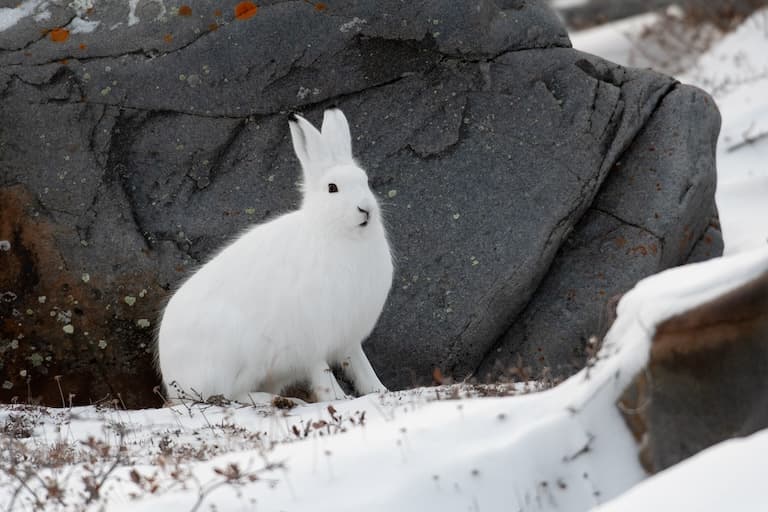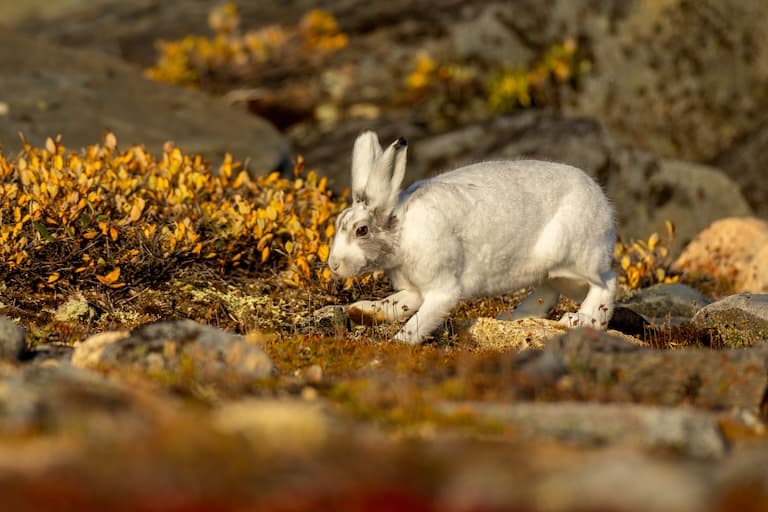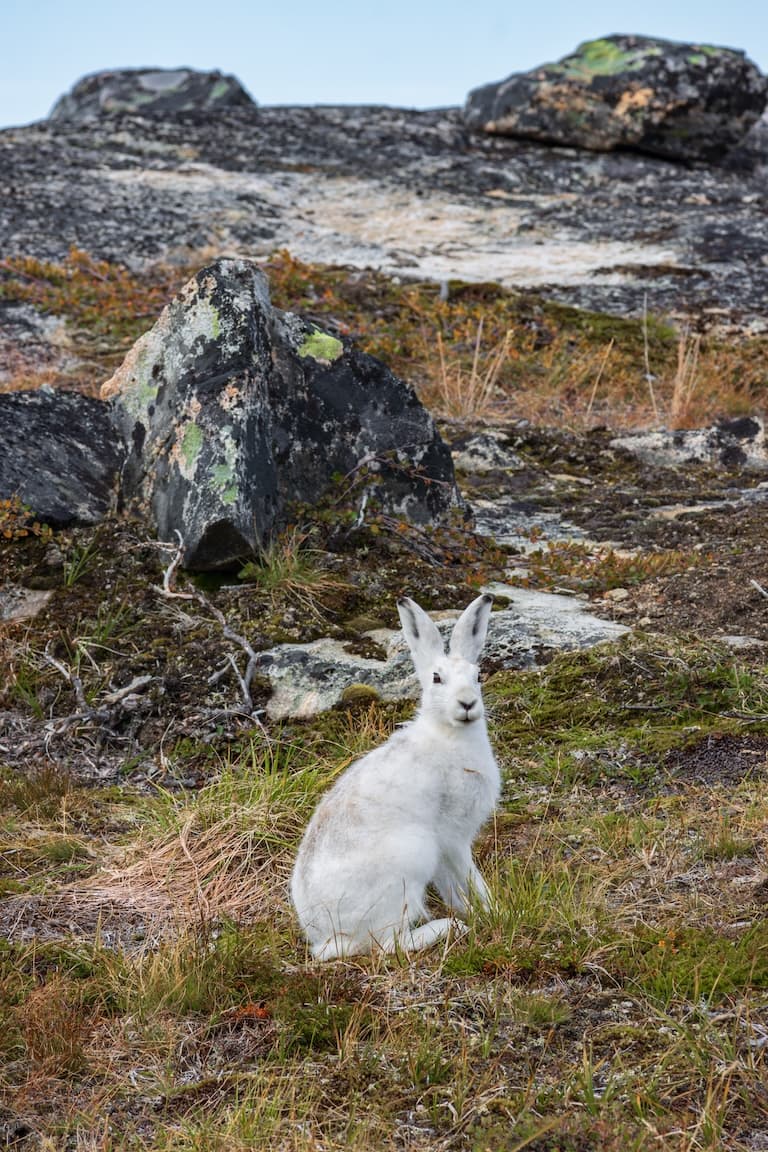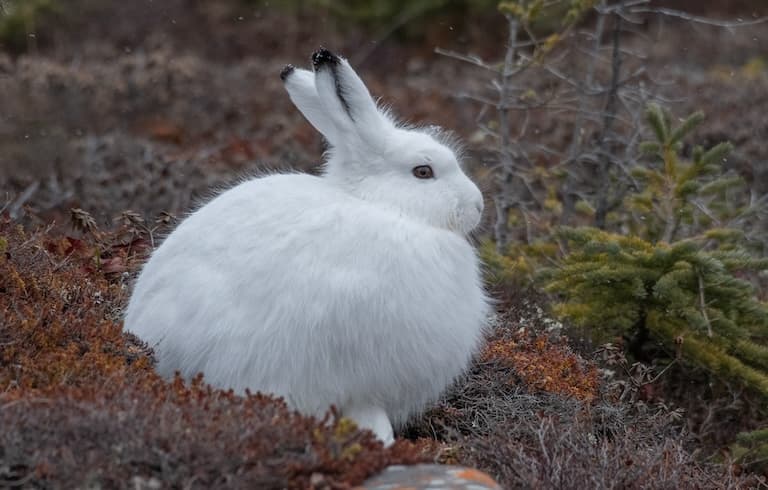Arctic Hare Profile
We’ve said it before, and we’ll say it again. Of all the animals, the hare is the most uniquely qualified to defend the United Animals Federation against the expansionist toad empire.
They’re smart, they’re fast, and they’re charismatic. They also work well with psychic cats.
The Arctic hare is all of the above (except maybe the cat thing) and a great representation of hare kind.

Arctic Hare Facts Overview
| Habitat: | Polar; mountainous, rocky tundra |
| Location: | Greenland, Northern Canada |
| Lifespan: | Possibly up to 5 years in the wild, less than one year in captivity |
| Size: | Up top 80cm (32 in) including tails |
| Weight: | Up to 7 kg (15 lb) |
| Colour: | White, sometimes brown in the summer |
| Diet: | Woody plants, lichens, and mosses in the winter; berries, buds, leaves and roots in the summer; sometimes carrion |
| Predators: | Foxes, wolves, lynx, ermines, raptors, humans |
| Top Speed: | 64 km/h (43 mph) |
| No. of Species: | 1 |
| Conservation Status: | Least Concern |
Arctic hares are enormous, and highly adapted to surviving where no rabbit would dare to set foot.
They’re cold weather specialists, and despite their size can still, as they say, haul scut – which they have to, quite often, as they live in a predator-rich world.
These are true wild hares, that don’t do well in captivity at all, but fortunately, they don’t have to, as their wild populations are still doing very well.
Interesting Arctic Hare Facts
1. Large lagomorphs
Arctic hares are, unsurprisingly, hares. This puts them firmly within the Lagomorpha order, which is where rabbits live, too. As rodent-like as they may appear, these two orders diverged at the earliest sign of mammalian freedom: right at the KT extinction boundary.
Lagomorphs aren’t nearly as diverse as rodents, the latter being the most diverse of all mammal orders, but they are still very cool. Well, not rabbits so much, but hares are, at least.
They’re bigger, tougher, faster, and they have four more chromosomes to boast about than rabbits. More tellingly, they have not ever been domesticated because they’re just too independent to give a hoot about what we might want from them.
They also have jointed skulls, which is basically a condition of unfused bones in the head that allow for more shock absorption as the hare rampages at speed across the ground.
So, with the establishing scene covered, hares are undoubtedly cool animals, and the Arctic hare is one of the coolest of the lot. Figuratively and literally. It’s been there for thousands of years, having diverged from the Alaskan hare and grown into one of the largest living lagomorphs on the planet.
Arctic hares can grow to 7 kg in weight and are almost a metre long in the extreme. Being big is useful in cold regions, as it means there’s more mass to hold onto heat, but it comes at the cost of needing more food. Luckily, the Arctic hare isn’t a fussy eater.

2. They’re tough as nails
This species has multiple adaptations to adjust to life in some of the more frigid regions of the globe. Its 20% fat content makes it a more balanced diet than the humble rabbit, which has a very lean 6%.
In combination with the blubber layer, it also has a dense coat of thick fur and digs holes in the ground to escape the worst of the chilly breezes.
The plumpness and fossorial behaviour make it look a bit like a rabbit, as do its shortened ears and legs – another adaptation to holding onto heat, but as Zach de la Rocha would say “There be no rabbits here”. They just wouldn’t be able to tough it out.
Another adaptation to the harsh environment is their ability to eat anything. Woody plants, moss, roots, bark, and all that uninspiring kind of junk, make up the majority of their diets during winter, but they jump at the chance for berries and legumes when summer comes around.
Arctic hares have even been seen chewing on the intestines of a dead caribou, which is exactly as metal as you’d expect from a hare. They wash all of this down with a mouthful of snow for hydration. 1
3. They’re more social than other hares
Hares, unlike rabbits, aren’t desperate for the validation they receive from their peers, and generally spend their lives alone. The Arctic hare is more or less a solitary animal but clumps up in small groups from time to time, and sometimes even gathers in much larger groups for interaction.
Sometimes they’ll even travel together, but they are still hares, and spend the majority of time in solitude.

4. But just as fast
Arctic hares are all-terrain animals, able to swim, hop or sprint over almost all surfaces. Their running ability is seriously impressive, reaching speeds of up to 63 km/h flat out, and even leaping right up in the air from a sitting position.
This comes in handy more often than they would like.
5. And they need to be
The Arctic isn’t as barren as it looks. While plants are hard to come by, the plentiful animals that have figured out how to find them support a wide range of animals who will simply eat them, instead.
Red foxes, arctic foxes, wolves, lynxes, mustelids, hawks, falcons and perhaps the most charismatic Arctic predator: the snowy owl, all routinely pressure this hare to move out of the way quickly.
Wolves are its top threat, with even puppies learning the ropes on the hare’s juveniles. Gyrfalcons chop the baby hares into pieces when they catch one, bringing chunks back to the nest separately. 2
6. They can change colour
Arctic winters are pretty bleak, and what little daylight there is illuminates the vast whiteness of the world’s snow cap.
So, the hare grows a thick white coat to blend in. But as the snow melts, at least in the lower latitudes of its range, this coat sheds to be replaced with a muddy brown coat, much like the marshy heathland that emerges from under the snow.
But farther up North, this so-called summer is only a few weeks long, so populations up there don’t bother with the colour change at all.
7. They’re doing ok
All of these incredible adaptations on top of the hare’s inherent stiff-upper-lip have meant that this is a species that’s still doing well, despite all the chaos going on everywhere else.
Local human populations that have evolved with them over time, take only around 5% of the total population and this is well within their natural reproductive capacity. The conservation status of the Arctic hare is of least concern. 3

Arctic Hare Fact-File Summary
Scientific Classification
| Kingdom: | Animalia |
| Phylum: | Chordata |
| Class: | Mammalia |
| Order: | Lagomorpha |
| Family: | Leporidae |
| Genus: | Lepus |
| Species: | arcticus |
Fact Sources & References
- Brooke Betzler, “Lepus arcticus Arctic hare”, Animal Diversity Web.
- Travis L. Booms (2003), “GYRFALCON DIET IN CENTRAL WEST GREENLAND DURING THE NESTING PERIOD”, BioOne Digital Library.
- “Arctic Hare”, IUCN Red List.
